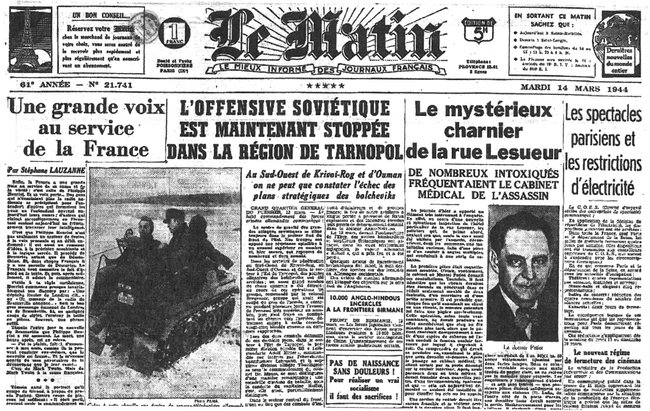
© The New York Times
Three months before D‑Day, in 1944, some Parisians in the chic 16th Arrondissement started complaining about thick smoke with an acrid smell emanating from the stately town house at 21 rue Le Sueur. Worried about a chimney fire, one neighbor finally called the authorities. They discovered that the mansion's basement was festooned with human bones, its coal stove burning body parts. A smaller outbuilding housed a mysterious, virtually soundproof triangular room. The former stable hid a pit about 10 feet deep filled with quicklime and rotting flesh.
Thus was uncovered one of history's most macabre bouts of serial killing. The official victim count was 27; other estimates ranged sharply upward.
The investigation soon centered on the building's owner, Marcel Petiot, a quick-witted, charming doctor with a checkered past. Petiot finagled state reimbursement for unorthodox treatments, often double-dipping by charging patients too, and was implicated in narcotics dealing.
He also claimed to be part of a Resistance organization helping people, especially Jews, escape Nazi Europe, for a sizable fee.
But as Commissaire Georges-Victor Massu, chief of the Brigade Criminelle, discovered, few if any of Petiot's clients made it to their destinations. The increasingly rich Petiot collected their money and possessions, which he stashed at several properties he had somehow acquired around the Nazi-dominated city. As the inevitable media frenzy began, the unavoidable question in occupied Paris soon arose:
Was Petiot working for the Gestapo? The Resistance? Both? Or neither?David King, the author of
Vienna, 1814, has more than just fresh eyes and imaginative speculation to power his revisiting of this long-forgotten true crime. Piqued by a contemporary account he found at an antiquarian bookshop, he gained access to the extensive police records of the case, which had been classified for six decades. The wealth of quotidian detail suffusing his well-paced narrative is one rewarding result of his sifting. Another is the sweeping cast of characters in
Death in the City of Light: they reflect the moral, political and personal tangles in Paris that the Nazi occupation fostered and that the French, after liberation, selectively pursued or buried.
Occupied Paris became a Nazi Babylon, and the French police were firmly under Gestapo control. Massu, a real-life model for Georges Simenon's Inspector Maigret, initially assumed the Gestapo was behind the carnage at 21 rue Le Sueur, so until he received German orders, he delayed drawing up a warrant for Petiot's arrest or even trying to question him. Nor did Massu dare to question Henri Lafont, an underworld chieftain with tantalizing links to Petiot. Lafont, Massu knew, worked with the Germans to infiltrate the Resistance, search for downed Allied airmen and ransack the French economy; after becoming a naturalized German citizen and an SS member, he was untouchable. After liberation, Massu, like many of his colleagues, was jailed as a collaborator. (He was eventually exonerated and reinstated.)
Meanwhile, Petiot, whom the Gestapo had jailed and tortured as an alleged Resistance member in 1943, evaded arrest by the French police for seven months. During his final weeks at large, he had successfully masqueraded as a Free French Army officer investigating himself.
Covered by newspapers and magazines in this country, Petiot's 1946 trial was more farce than quest for truth. Under French law, attorneys representing interested civil parties, like the families of the disappeared, had the right to jump into the proceedings willy-nilly. So they joined the muddled prosecutors, the defense attorney (an expert at deflecting telling legal points) and the defendant himself in trading bons mots, insults, allegations and insinuations. This judicial circus trampled over potentially useful lines of inquiry and evidence. The verdict declared Petiot guilty, and he was sentenced to death. But many key questions remain unanswered.
Among them:
Who was Petiot working with? King concludes that Petiot was a "self-appointed executioner for Hitler," and fashions a suggestive argument from informed conjecture and circumstantial evidence. But as with so much during the occupation, the full answer may have been more complex and revealing than the French wanted to know.
Gene Santoro's most recent books are
Myself When I Am Real, a biography of Charles Mingus, and
Highway 61 Revisited, an essay collection about American music.
Reader Comments
to our Newsletter